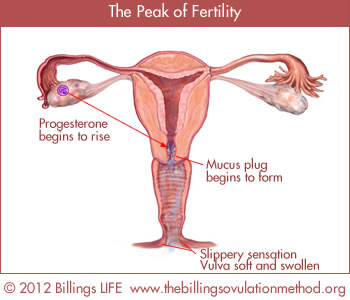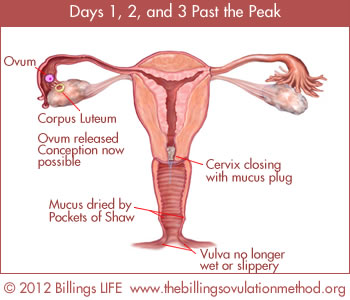
The Peak of Fertility: Ovulation is very close - the egg will soon be released from its follicle. Then it will be swept up into the fallopian tube, ready to begin its journey towards the uterus. |

Days 1, 2, and 3 past the Peak: If fertilisation doesn't occur the egg will die within a day of ovulation. But if the egg meets any sperm along the way, fertilisation can take place. After ovulation the empty follicle is transformed into the Corpus Luteum. The Corpus Luteum produces a hormone called progesterone. Progesterone prepares the endometrium in case there's a fertilised egg ready to implant. It also causes the mucus to thicken, and the plug to begin forming in the cervix again. The day following the Peak you'll no longer feel wet or slippery at the vulva. By the end of three days after the Peak your fertility for this cycle is over. |
Both clinical and laboratory studies have shown that the last day of the slippery sensation is the most fertile time in the cycle. It is called the Peak of fertility because it is the day when sex is most likely to result in a pregnancy. Studies show that ovulation usually occurs within a day of the Peak. It is important to realise that the Peak isn't necessarily the day of most mucus. The slippery, lubricative sensation may last a day or two after the visible signs of mucus, which means you're still highly fertile – the sensation is the more valuable symptom.
Trials by the World Health Organisation have shown that over 90% of women can identify the fertile phase and the Peak day of fertility in the first month of observation and charting.
Although an experienced user of the Billings Ovulation Method® can often recognise her Peak day as it is occurring, it can only be verified the following day when you no longer feel slippery. The change after the Peak day may be to dry or sticky, occasionally damp, but definitely not slippery.
Once the Peak has been recognised the Peak Rule can be applied: If you don't want to conceive, you need to avoid sex for three days following the Peak. This allows for the latest possible time that ovulation may occur (up to 48 hours after Peak) and for the lifespan of the egg (maximum 24 hours). From the fourth morning past the Peak until the end of the cycle you're infertile – the egg is dead and you won't ovulate again until after the next menstruation.






